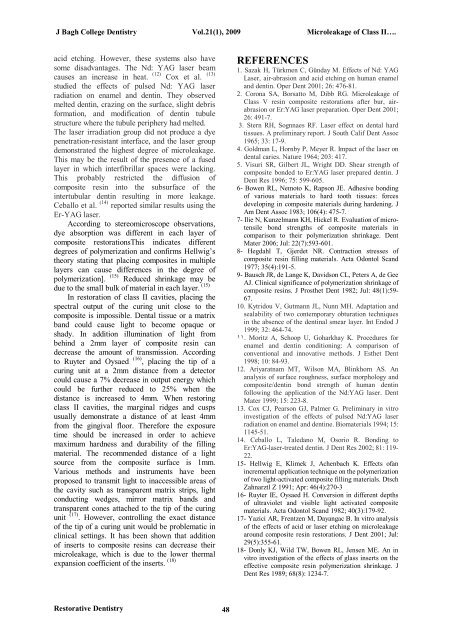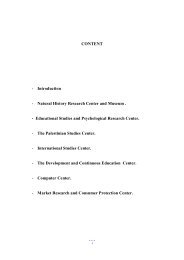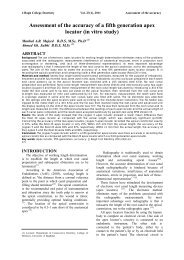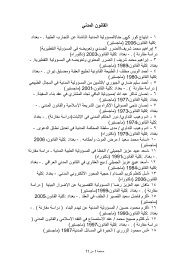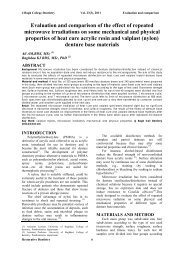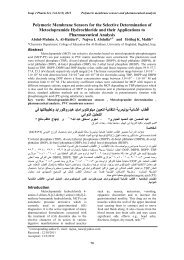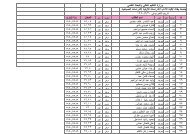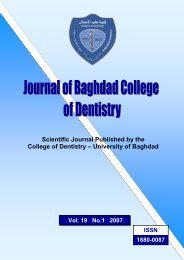Vol 21 No. 1
Vol 21 No. 1
Vol 21 No. 1
You also want an ePaper? Increase the reach of your titles
YUMPU automatically turns print PDFs into web optimized ePapers that Google loves.
J Bagh College Dentistry <strong>Vol</strong>.<strong>21</strong>(1), 2009 Microleakage of Class II….<br />
acid etching. However, these systems also have<br />
some disadvantages. The Nd: YAG laser beam<br />
(12)<br />
causes an increase in heat. Cox et al. (13)<br />
studied the effects of pulsed Nd: YAG laser<br />
radiation on enamel and dentin. They observed<br />
melted dentin, crazing on the surface, slight debris<br />
formation, and modification of dentin tubule<br />
structure where the tubule periphery had melted.<br />
The laser irradiation group did not produce a dye<br />
penetration-resistant interface, and the laser group<br />
demonstrated the highest degree of microleakage.<br />
This may be the result of the presence of a fused<br />
layer in which interfibrillar spaces were lacking.<br />
This probably restricted the diffusion of<br />
composite resin into the subsurface of the<br />
intertubular dentin resulting in more leakage.<br />
Ceballo et al. (14) reported similar results using the<br />
Er-YAG laser.<br />
According to stereomicroscope observations,<br />
dye absorption was different in each layer of<br />
composite restorationsThis indicates different<br />
degrees of polymerization and confirms Hellwig’s<br />
theory stating that placing composites in multiple<br />
layers can cause differences in the degree of<br />
polymerization]. (15) Reduced shrinkage may be<br />
due to the small bulk of material in each layer. (15)<br />
In restoration of class II cavities, placing the<br />
spectral output of the curing unit close to the<br />
composite is impossible. Dental tissue or a matrix<br />
band could cause light to become opaque or<br />
shady. In addition illumination of light from<br />
behind a 2mm layer of composite resin can<br />
decrease the amount of transmission. According<br />
to Ruyter and Oysaed (16) , placing the tip of a<br />
curing unit at a 2mm distance from a detector<br />
could cause a 7% decrease in output energy which<br />
could be further reduced to 25% when the<br />
distance is increased to 4mm. When restoring<br />
class II cavities, the marginal ridges and cusps<br />
usually demonstrate a distance of at least 4mm<br />
from the gingival floor. Therefore the exposure<br />
time should be increased in order to achieve<br />
maximum hardness and durability of the filling<br />
material. The recommended distance of a light<br />
source from the composite surface is 1mm.<br />
Various methods and instruments have been<br />
proposed to transmit light to inaccessible areas of<br />
the cavity such as transparent matrix strips, light<br />
conducting wedges, mirror matrix bands and<br />
transparent cones attached to the tip of the curing<br />
unit (17) . However, controlling the exact distance<br />
of the tip of a curing unit would be problematic in<br />
clinical settings. It has been shown that addition<br />
of inserts to composite resins can decrease their<br />
microleakage, which is due to the lower thermal<br />
expansion coefficient of the inserts. (18)<br />
REFERENCES<br />
1. Sazak H, Türkmen C, Günday M. Effects of Nd: YAG<br />
Laser, air-abrasion and acid etching on human enamel<br />
and dentin. Oper Dent 2001; 26: 476-81.<br />
2. Corona SA, Borsatto M, Dibb RG. Microleakage of<br />
Class V resin composite restorations after bur, airabrasion<br />
or Er:YAG laser preparation. Oper Dent 2001;<br />
26: 491-7.<br />
3. Stern RH, Sognnaes RF. Laser effect on dental hard<br />
tissues. A preliminary report. J South Calif Dent Assoc<br />
1965; 33: 17-9.<br />
4. Goldman L, Hornby P, Meyer R. Impact of the laser on<br />
dental caries. Nature 1964; 203: 417.<br />
5. Visuri SR, Gilbert JL, Wright DD. Shear strength of<br />
composite bonded to Er:YAG laser prepared dentin. J<br />
Dent Res 1996; 75: 599-605.<br />
6- Bowen RL, Nemoto K, Rapson JE. Adhesive bonding<br />
of various materials to hard tooth tissues: forces<br />
developing in composite materials during hardening. J<br />
Am Dent Assoc 1983; 106(4): 475-7.<br />
7- Ilie N, Kunzelmann KH, Hickel R. Evaluation of microtensile<br />
bond strengths of composite materials in<br />
comparison to their polymerization shrinkage. Dent<br />
Mater 2006; Jul: 22(7):593-601.<br />
8- Hegdahl T, Gjerdet NR. Contraction stresses of<br />
composite resin filling materials. Acta Odontol Scand<br />
1977; 35(4):191-5.<br />
9- Bausch JR, de Lange K, Davidson CL, Peters A, de Gee<br />
AJ. Clinical significance of polymerization shrinkage of<br />
composite resins. J Prosthet Dent 1982; Jul: 48(1):59-<br />
67.<br />
10. Kytridou V, Gutmann JL, Nunn MH. Adaptation and<br />
sealability of two contemporary obturation techniques<br />
in the absence of the dentinal smear layer. Int Endod J<br />
1999; 32: 464-74.<br />
١١. Moritz A, Schoop U, Goharkhay K. Procedures for<br />
enamel and dentin conditioning: A comparison of<br />
conventional and innovative methods. J Esthet Dent<br />
1998; 10: 84-93.<br />
12. Ariyaratnam MT, Wilson MA, Blinkhorn AS. An<br />
analysis of surface roughness, surface morphology and<br />
composite/dentin bond strength of human dentin<br />
following the application of the Nd:YAG laser. Dent<br />
Mater 1999; 15: 223-8.<br />
13. Cox CJ, Pearson GJ, Palmer G. Preliminary in vitro<br />
investigation of the effects of pulsed Nd:YAG laser<br />
radiation on enamel and dentine. Biomaterials 1994; 15:<br />
1145-51.<br />
14. Ceballo L, Taledano M, Osorio R. Bonding to<br />
Er:YAG-laser-treated dentin. J Dent Res 2002; 81: 119-<br />
22.<br />
15- Hellwig E, Klimek J, Achenbach K. Effects ofan<br />
incremental application technique on the polymerization<br />
of two light-activated composite filling materials. Dtsch<br />
Zahnarztl Z 1991; Apr: 46(4):270-3<br />
16- Ruyter IE, Oysaed H. Conversion in different depths<br />
of ultraviolet and visible light activated composite<br />
materials. Acta Odontol Scand 1982; 40(3):179-92.<br />
17- Yazici AR, Frentzen M, Dayangac B. In vitro analysis<br />
of the effects of acid or laser etching on microleakage<br />
around composite resin restorations. J Dent 2001; Jul:<br />
29(5):355-61.<br />
18- Donly KJ, Wild TW, Bowen RL, Jensen ME. An in<br />
vitro investigation of the effects of glass inserts on the<br />
effective composite resin polymerization shrinkage. J<br />
Dent Res 1989; 68(8): 1234-7.<br />
Restorative Dentistry<br />
48


